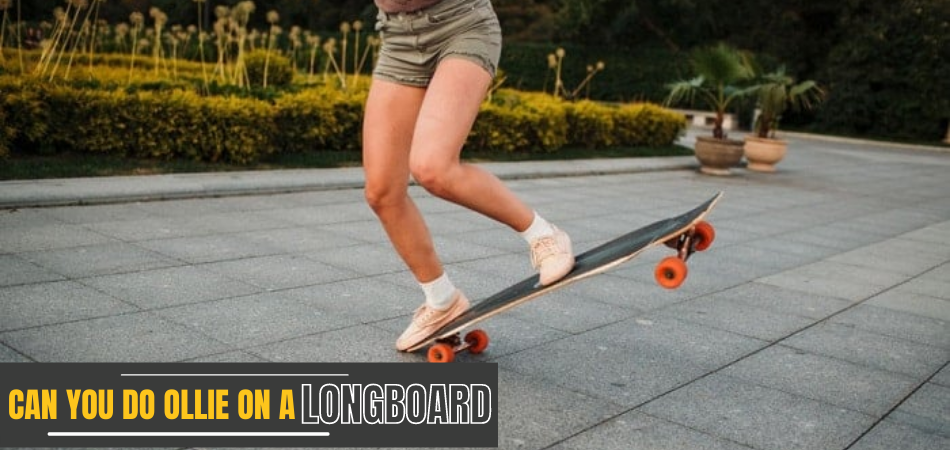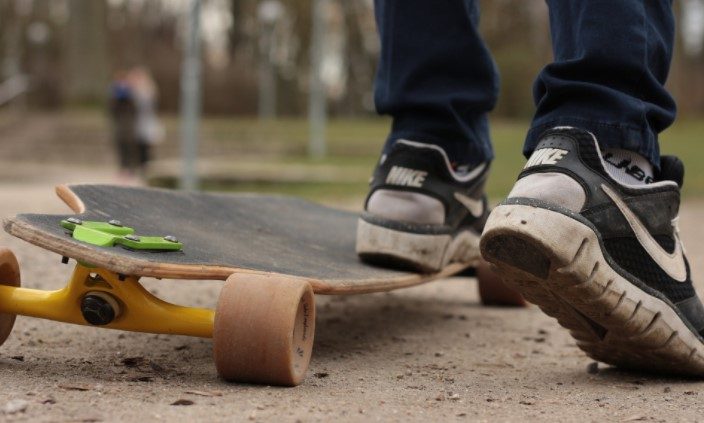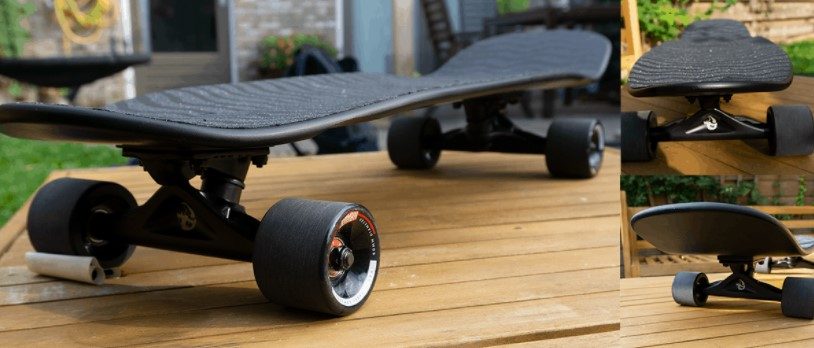You can, absolutely, do an Ollie on any longboard at all. However, you need to master some tricks that involve weight, skill and practice. You also need to avoid making certain mistakes when doing an Ollie on a longboard. Don’t worry, we’re going to tell you everything you need to know to begin.
You are in this article because you want to learn how to do an Ollie on a longboard. Rest assured, you are in for a safe ride! We are here to provide you with everything you need to know about Ollies, from the most basic instructions and steps to the more advanced tricks and concepts that involve the Ollie.
Can You Do An Ollie On A Longboard?
The answer is yes! Ollies are a part of skateboarding that seem completely impossible to many people, but trust me – anyone can do an Ollie if they learn how (and practice, practice, practice).

Understand: a “longboard” is a type of skateboard. The difference between the Longboard and traditional skateboards is that longboards are longer than regular skateboards but don’t worry, they are totally affordable. You can get an affordable longboard under 150 bucks at most board stores.
Longboards are more stable than traditional skateboards because their length provides greater leverage, making them easier to control. However, they are still quite difficult to ride and require a lot of practice to master.
How To Do Ollie On A Longboard
Doing an Ollie on a longboard involves using your legs to lift yourself high enough to jump off the ground and push off with your foot, which allows you to travel over obstacles easily. This move requires you to shift your body weight to get the right amount of force for you to jump off of the ground and have a good balance so that you don’t fall off your board.
Below are steps to do an Ollie on a Longboard:
- Find your centre: First, you need to find your centre of gravity. You lean forward and backwards to shift your weight.
- Hopping on both feet: It would help if you had a good stance. Stand with feet shoulder-width apart, a slight bend in your knees, head up and centred over the board and arms straight out in front.
- Push hard on the back wheels: It’s important to push hard on the back wheels because this will provide more stability for you when you’re trying to do an Ollie.
- Pull with the arms: After that, pull with the arms. Drawing with the arms will help lift the board off the ground as it is being pushed forward by the back wheels.
- Turn your front foot backwards: It’s also important to turn your front foot backwards. This will help you achieve proper balance and keep yourself steady as you do an Ollie.
- Picking a landing spot: As soon as your front foot is pointing backwards, it’s time to lift your back foot so you can start doing an Ollie. This is done by pushing hard on the rear wheels while pulling with the arms, turning your front foot backwards and picking a landing spot.
- Land on the wheels and knees first: Once you’ve picked a landing spot, it’s time to land on the wheels and knees first or else you’ll end up face planting or hitting something solid like a curb if there isn’t anything soft between you and the surface below.
- Ollie using too much force: The trick requires a certain amount of power, but too much can cause problems for both your body and your board. So you need to know when exactly to use enough force and when to back off.
- Using little force over balancing is key: The key to an Ollie is minimal force. This means using just enough force to balance on top of your board without any extra effort. You know that you are balanced when you feel like you have no effort at all in holding yourself up.
Mistakes That I Have Made When Doing An Ollie On A Longboard
Longboards can be used for many different activities. Some races use longboards, some tricks can be done with them, and they can even be used for transportation purposes. With each use comes some mistakes that could have been avoided.
Here are some mistakes that I have made using this board:
- The biggest mistake was not practising enough. I would only practice on a skateboard and not on the actual Longboard.
- Not mastering the basics first. When I first started, I just jumped down from my skateboard and tried to do an Ollie on a longboard, which is not a good way to go about it.
- Not applying enough force to the tail of the board. When I wondered why my Ollies would not work, a friend suggested that I try pushing my back foot harder against the bottom of my Longboard. This worked very well for me when trying to get air; this allowed me to get higher and higher each time I practised.
- Thinking too much about what was going on during each jump. I would focus too much on making sure that my feet were in the right position at all times while learning how to do an Ollie On A Longboard, and then try to remember this to repeat the same motion, again and again, each time I attempted it. However, instead of thinking about where my feet were supposed to be, I should have focused more on the entire process.
Is Ollie Safe For Longboarding?
Not exactly. However, with experienced skateboarders, doing an Ollie is much less dangerous, especially when compared to the attempts of a beginner. It can be hazardous to do Ollie with Longboard, so you need to learn some safety tips first to make it safe.

Doing Ollie is one of the most common moves in skateboarding, and it involves using force to propel yourself off a ramp or other kind of platform. You may have heard that doing Ollie with Longboard is very hard because you have to have good balance and control over your body, and you also need a good technique for doing this trick. This is true, but it does not mean it’s impossible to do.
So, We Give You A Few Tips To Help You Avoid The Risks:
- Gear: The most important thing of all is that you must wear a helmet. Also, wear knee pads and elbow pads because they will protect your knees and elbows from getting hurt during fall after Ollie.
- Place: Please choose a smooth surface for Ollie, such as a basketball court or gymnasium floor. Do not try doing tricks on rough grounds or uneven surfaces because this may cause injuries such as sprained ankles.
- Technique: To do the Ollie with Longboard successfully, take action with your legs first and then hips next, and finally push your back foot forward to lift off the ground. Do not forget about arms: use them to balance yourself when landing after a jump.
- Safety gear for landing: When you land after jumping on a Longboard, please do not put your feet together; it will make you lose balance easily. Put one foot in front of another to hold yourself steady as much as possible when landing after jumping. And stay aware of your surroundings.
Is a Heavy Longboard Good For Ollie?
Yes, considering a list of the longboards for beginners, you will find that a high-quality heavy cruiser board is suitable for doing Ollie.

But what’s the difference between a board that’s good for jumping and one that’s not?
Firstly, it should have a kicktail. Some manufacturers produce longboards with kicktails, but cocktails are essential if you want to do tricks because they give you more stability while performing those tricks.
Secondly, weight is important. The heavyweight provides extra stability, and it’s also easier to ollie with a heavier deck. But be careful not to get too heavy a deck because it will be difficult to handle.
It’s all about the balance. A heavy longboard can help you learn to make your body balance the whole weight of your board.
As a longboarder, the trick is to figure out how to shift your weight from one foot to another so that you can balance the board.
It is often easier to use more of your body than just your feet when you are first learning this. For example, instead of just moving your feet forward or backwards, try leaning forward or back too.
When you are learning, you want as much weight as possible under your feet and on the board. If you put your weight mostly on the side of your body, it will be harder to change directions.
The easiest way to get this with a normal longboard is to use more of your body (legs and arms). But when it comes time to pop the board up high, this weight distribution isn’t enough. Here a heavy longboard will help! Because it makes balancing easier!
Truck and Wheels
The first thing that you need to consider before choosing a heavy longboard is the truck and wheel combination. This combination will have a greater weight than your regular skateboarding set-up most of the time. You must choose a skateboard where the truck and wheel combination will support its additional weight. If it cannot support its extra weight, it will damage your board and yourself.
It is also important that you choose a skateboard where its truck can support its weight and maintain stability in every situation possible. Note that peace is very important if you want to ensure that your tricks will turn out well without any problem.
Here are a few things I’ve learned over the years of boarding:
1. Boards
There are many different sizes, shapes and styles out there. You have to decide what you like based on your local terrain, riding style and ability level. Each board generally has its feel and characteristics, so try a bunch before deciding which one is best for you.
2. Trucks
These are the axle supports for your wheels. They should be sized for your weight and style of skating, but you can usually change trucks if they don’t fit right. Please make sure they are tight enough, so the wheel doesn’t come off while you’re riding, but not so close that they don’t turn freely.
3. Wheels
There’s a lot to consider here depending on how you ride, what kind of surface you skate on, how fast you go, etc… Harder wheels typically last longer, grip better in turns, and slide easier due to less surface area friction when turning (and faster speeds). Soft wheels are more forgiving when carving at slower speeds but tend to wear down more quickly with speedier riding speed or cracks in the pavement.
When you first start out doing Ollie with a longboard, there are a few things that you need to keep in mind. Although these are pretty simple and easy to follow, many people overlook them.
Tighten Your Trucks
As a beginner, you should always tighten the trucks of your Longboard as much as possible. This will make it easier for you to perform Ollies with your Longboard. As time passes and you get better at riding on a longboard, you can start adjusting the tightness of the trucks depending on how good you have become at performing Ollies.
One Stance
It would help if you always tried to stick with one stance while learning how to do Ollies. This will reduce the risk of accidents and help you easily master the art of performing Ollie. Once you become an expert at doing Ollies, you can try changing your stance whenever you feel like it.
It would be best if you had enough speed.
When learning how to do Ollie on a longboard, make sure that you have enough speed before attempting this trick. If possible, ride downhill or find another way to increase your speed before trying this trick out. With enough speed, it is going to be easier.
In the act of doing an Ollie on a longboard, you should be aware of the following things:
- You need to be very light on your feet.
- You don’t need to kick off the ground with your foot; rather, it is sufficient to push off with your toes and keep your feet on the board while doing Ollie.
- You need to push off from the ground with considerable force but without losing balance in the process.
- You should bend your knees and keep them bent as much as possible during the time you are in the air.
- You should have a smooth and steady motion to get maximum height from Ollie.
- Your timing should be just right, and you should try to focus on how to do it right instead of worrying about what will happen if you do it wrong since this will only cause tension which is not good for you while doing Ollie on a longboard.
Final Words
So, can you do Ollie with Longboard or not? Yes, if you have enough skills and get a perfect combination between Longboard and your body movement, you can do an Ollie. Also, while learning to do an Ollie with a longboard, you should concentrate on balance and accuracy by practising. This all depends on your logic, force and will. After getting the right techniques of Ollie done, with practice, you’ll be able to master the art of doing ollies with the Longboard.